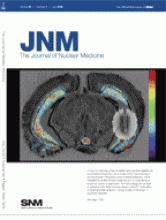Abstract
In patients with oral head and neck cancer, the presence of metallic dental implants produces streak artifacts in the CT images. These artifacts negate the utility of CT for the spatial localization of PET findings and may propagate through the CT-based attenuation correction into the PET images. In this study, we evaluated the efficacy of an algorithm that reduces metallic artifacts in CT images and the impact of this approach on the quantification of PET images. Methods: Fifty-one patients with and 9 without dental implants underwent a PET/CT study. CT images through the patient's dental implants were reconstructed using both standard CT reconstruction and an algorithm that reduces metallic artifacts. Attenuation correction factors were calculated from both sets of CT images and applied to the PET data. The CT images were evaluated for any reduction of the artifacts. The PET images were assessed for any quantitative change introduced by metallic artifact reduction. Results: For each reconstruction, 2 regions of interest were defined in areas where the standard CT reconstruction overestimated the Hounsfield units (HU), 2 were defined in underestimated areas, and 1 was defined in a region unaffected by the artifacts. The 5 regions of interest were transferred to the other 3 reconstructions. Mean HU or mean Bq/cm3 were obtained for all regions. In the CT reconstructions, metallic artifact reduction decreased the overestimated HUs by approximately 60% and increased the underestimated HUs by approximately 90%. There was no change in quantification in the PET images between the 2 algorithms (Spearman coefficient of rank correlation, 0.99). Although the distribution of attenuation (HU) changed considerably in the CT images, the distribution of activity did not change in the PET images. Conclusion: Our study demonstrated that the algorithm can enhance the structural and spatial content of CT images in the presence of metallic artifacts. The CT artifacts do not propagate through the CT-based attenuation correction into the PET images, confirming the robustness of CT-based attenuation correction in the presence of metallic artifacts. The study also demonstrated that considerable changes in CT images do not change the PET images.
Footnotes
-
COPYRIGHT © 2008 by the Society of Nuclear Medicine, Inc.







